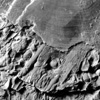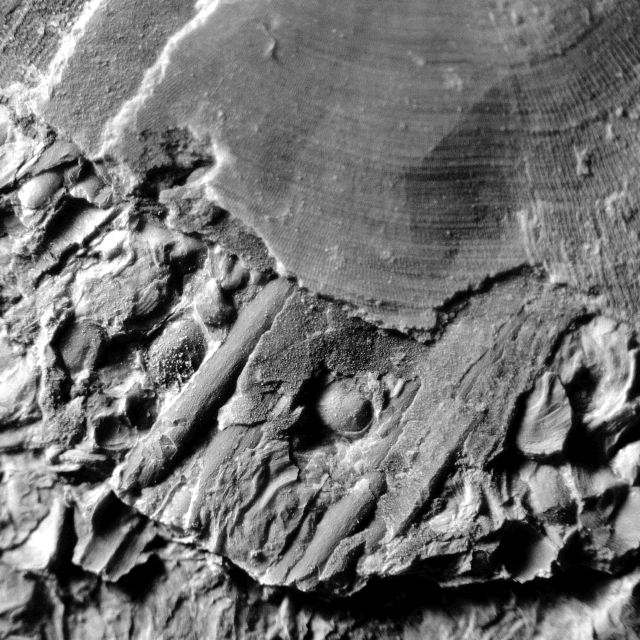Stomach contents
It happened from time to time that fish died with a full stomach at Miguasha and their last meal became fossilized with the rest of their remains.
 (100 kb) These uncommon discoveries not only tell us about a predator’s preferred prey, they also provide valuable information about the anatomy of its digestive system.
(100 kb) These uncommon discoveries not only tell us about a predator’s preferred prey, they also provide valuable information about the anatomy of its digestive system.
Some predatory fish have been found with whole prey in their abdominal cavity, the most astounding example being a 19-cm long Homalacanthus in the belly of a 46-cm long Eusthenopteron. Swallowed head first, the Homalacanthus accounts for 40% of the predator’s body length, indicating the great extent to which its digestive tract could expand. Although impossible to know for certain, the death of this predator may have been due to the enormous size of its meal!
Some species apparently did not hesitate to eat smaller members of their own kind. For example, a Cheirolepis was found within the abdomen of another Cheirolepis, and two Eusthenopteron were observed inside two larger individuals. These are undoubtedly among the oldest cases of vertebrate cannibalism.
Stomach contents in the dipnoan fish Scaumenacia are also quite telling. It fed primarily on small invertebrates, with up to thousands of the small crustacean Asmusia – apparently the only species ever ingested – in its digestive tube.
Even in the absence of stomach contents, the outlines of digestive systems are sometimes visible in the agnathans Euphanerops and Endeiolepis, and the sediment-filled digestive system has been preserved in the form of a cast in several specimens of Bothriolepis. With a ventrally positioned mouth, Bothriolepis fed itself by filtering mud at the bottom of the estuary, and a belly full of sediment helped fossilize its intestinal system. Internal casts, observable in some Bothriolepis specimens once cut into sections, display a concentric spiral like that observed in the intestines of modern day sharks, and is considered to be primitive gnathostome (jawed fish) morphology. Plant fragments in the cololite of a Bothriolepis specimen suggest that plants may have been part of its diet. Cololites are petrified intestinal contents, and the word comes from the Greek kolon for intestine, and lithos for rock.

 (100 kb) These uncommon discoveries not only tell us about a predator’s preferred prey, they also provide valuable information about the anatomy of its digestive system.
(100 kb) These uncommon discoveries not only tell us about a predator’s preferred prey, they also provide valuable information about the anatomy of its digestive system.Some predatory fish have been found with whole prey in their abdominal cavity, the most astounding example being a 19-cm long Homalacanthus in the belly of a 46-cm long Eusthenopteron. Swallowed head first, the Homalacanthus accounts for 40% of the predator’s body length, indicating the great extent to which its digestive tract could expand. Although impossible to know for certain, the death of this predator may have been due to the enormous size of its meal!
Some species apparently did not hesitate to eat smaller members of their own kind. For example, a Cheirolepis was found within the abdomen of another Cheirolepis, and two Eusthenopteron were observed inside two larger individuals. These are undoubtedly among the oldest cases of vertebrate cannibalism.
Stomach contents in the dipnoan fish Scaumenacia are also quite telling. It fed primarily on small invertebrates, with up to thousands of the small crustacean Asmusia – apparently the only species ever ingested – in its digestive tube.
Even in the absence of stomach contents, the outlines of digestive systems are sometimes visible in the agnathans Euphanerops and Endeiolepis, and the sediment-filled digestive system has been preserved in the form of a cast in several specimens of Bothriolepis. With a ventrally positioned mouth, Bothriolepis fed itself by filtering mud at the bottom of the estuary, and a belly full of sediment helped fossilize its intestinal system. Internal casts, observable in some Bothriolepis specimens once cut into sections, display a concentric spiral like that observed in the intestines of modern day sharks, and is considered to be primitive gnathostome (jawed fish) morphology. Plant fragments in the cololite of a Bothriolepis specimen suggest that plants may have been part of its diet. Cololites are petrified intestinal contents, and the word comes from the Greek kolon for intestine, and lithos for rock.
Site map | Feedback | Links | Sources | Credits
Stomach contents
<< Of predators and prey | Coprolites >>

Title: The tiny conchostracan Asmusia in the belly of a Scaumenacia specimen
Author: Parc national de Miguasha
Sources: Parc national de Miguasha
Year: 2003
Description:
The tiny chitin valves of Asmusia are sometimes found by the thousands in the stomachs of Miguasha fish. In this example, a big Scaumenacia – a dipnoan fish – ingested a gargantuan meal of the little crustaceans. The small valves are visible under the scales and strong bones that cover its abdomen.


